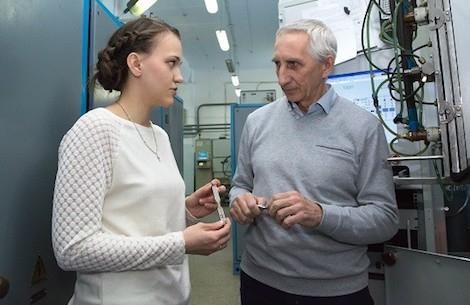Modified Metals for Space Engineering Produced in Submilliseconds
Scientists from Russia's Tomsk Polytechnic University and the Institute of High Current Electronics, SB RAS, have developed a method to apply wear-resistant coatings on metals, followed by fusing them in the substrate.

Maria Rygina and Professor Yuri Ivanov.
Scientists from Russia's Tomsk Polytechnic University (TPU) and the Institute of High Current Electronics, Siberian Branch Russian Academy of Sciences, have developed a method to apply wear-resistant coatings on metals, followed by fusing them into the substrate.
Such modified materials, through a combination of lightness, strength and corrosion resistance, can be used in mechanical engineering, aviation and space engineering. New materials are based on aluminum and silumin—an alloy of aluminum and silicon.
“These metals have low weight, good corrosion resistance. For use in air and space engineering, we only need to modify their strength and tribological properties: to improve hardness and wear resistance,” Maria Rygina says, a graduate student of the TPU Department of Nanomaterials and Nanotechnologies.
As coatings, polytechnicers use titanium, titanium nitride and silumin containing 25-percent silicon. The peculiarity of the developed method is that the coating is not deposited onto a substrate but fused into it by means of an intense pulsed electron beam. Experimental studies have shown that it resulted in almost six-fold improvement in the hardness of metal and three times the wear resistance.
World experts on materials science remark that the main challenge is now adhesion of the coating and the substrate. If the coating is simply deposited, then it can be easily removed. Foreign research teams are looking for a solution to this issue by forming multi-layer coatings. However, multi-layer deposition takes a long time.
"We offer fusing the coating in the substrate: this takes microseconds, and the adhesion is significantly improved,” says the project’s scientific head, Professor Yuri Ivanov, the TPU Department of Nanomaterials and Nanotechnologies.
To form coatings by such a method is possible due to specific electron-ion-plasma installations created by the scientists from IHCE SB RAS and TPU. As the developers say, the installations are unique and are supplied to Japan, China, Canada.
According to Maria Rygina, the modified metals can be used for manufacturing internal mechanisms’ parts in spacecrafts: It is those that are the most wearable. Currently this method is used in the production of woodworking tools and components for mechanical engineering.
For more information, visit tpu.ru/en.
Related Content
-
Anodizing for Bonding Applications in Aerospace
Anodizing for pre-prep bonding bridges the gap between metallic and composite worlds, as it provides a superior surface in many applications on aluminum components for bonding to these composites.
-
Finishing Systems Provider Celebrates 150 Years, Looks to Future
From humble beginnings as an Indiana-based tin shop, Koch Finishing Systems has evolved into one of the most trusted finishing equipment providers in the industry.
-
Bryan Leiker, MFACA, Discusses CARB Public Hearing Over Calif. Hex Chrome Ban
Bryan Leiker, executive director, Metal Finishing Association of California, offers a recap of a January 27, 2023, public hearing conducted by the California Air Resources Board prior to an impending ruling on a proposed ban of hexavalent chromium use for finishing operations in the state.















